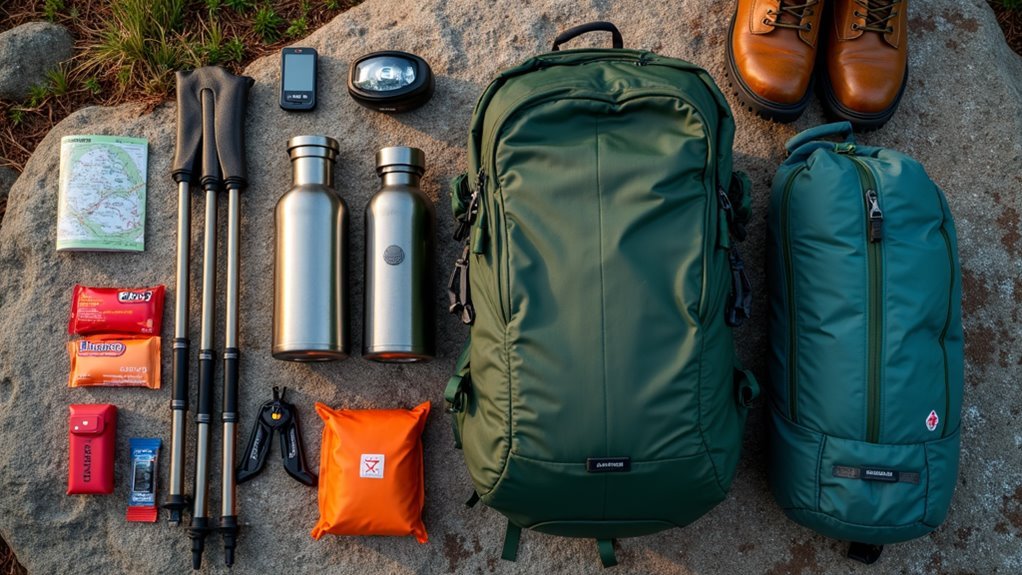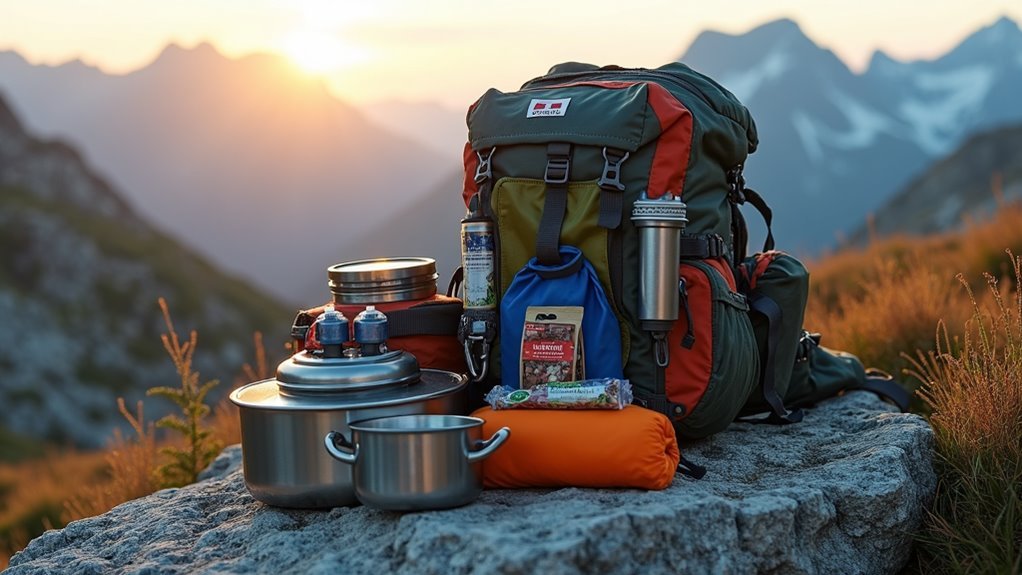I’ve found that mastering backpack packing really comes down to three key principles: distributing weight properly with heavier items near your back’s center, organizing gear by accessibility with emergency supplies in outer pockets, and choosing the right pack that stays under 30% of your body weight. Perhaps most importantly, I always cluster small items in stuff sacks—it prevents that frustrating moment when you’re digging through everything just to find a granola bar. These fundamentals will transform your hiking experience entirely.
Essential Gear Every Hiker Needs

Preparation makes all the difference between a memorable hike and a miserable one, though I’ll admit I’ve learned this the hard way more times than I’d like to count.
Experience taught me that thorough preparation separates an amazing adventure from a complete disaster you’ll regret for years.
Your first aid kit needs bandages, antiseptic cream, and tweezers—basic stuff that’ll save your day when things go sideways.
Navigation tools are non-negotiable. I always carry a GPS, map, and compass because technology fails when you need it most.
Perhaps the most overlooked items are insulation gear and sun protection. Pack a jacket, emergency blanket, and sunscreen. Trust me on this one.
Don’t forget fire supplies either.
Strategic Weight Distribution Techniques
Having all the right gear means nothing if you can’t carry it properly—something I figured out after my shoulders felt like they were on fire three miles into what should’ve been an easy day hike.
The secret lies in positioning heavier items toward your back’s center, creating stability rather than fighting against it. I think most people get this wrong initially—I certainly did.
Place medium-weight gear in the middle section, then fill the bottom with lighter items like your sleeping bag.
Perhaps the most important part is keeping that load close to your body by tightening those straps properly.
Optimizing Accessibility and Organization

While weight distribution keeps you balanced on the trail, smart organization determines whether you’ll actually find what you need when you need it—and trust me, there’s nothing worse than unpacking half your gear just to locate a granola bar.
I’ve learned to think in layers of urgency. Emergency items go in easily reachable pockets, while camp gear stays buried at the bottom.
Perhaps counterintuitively, I actually cluster small items together in stuff sacks rather than scattering them throughout—it feels more organized, even if it’s not always perfectly efficient.
Quick-access items deserve prime real estate in side compartments.
Choosing the Right Backpack for Your Adventure
Before you even think about what goes inside your pack, the backpack itself will make or break your entire hiking experience—I’ve seen too many people struggle with ill-fitting packs that turned what should’ve been enjoyable day hikes into endurance tests.
I think the weight limit rule matters more than anything else. Keep it under 30% of your body weight, perhaps even less if you’re starting out.
Function beats style every time—storage capability and comfort should guide your choice, not how cool it looks.
Consider the trails you’ll actually tackle, not your wildest dreams.
Frequently Asked Questions
How Do I Prevent My Gear From Getting Wet in Rainy Conditions?
I’ll waterproof my gear using dry bags or plastic liners inside my backpack. I’ll pack rain covers for electronics, keep spare clothes sealed, and guarantee my backpack has good water resistance for unexpected downpours.
What Should I Do if My Backpack Strap Breaks on the Trail?
I’d immediately stop hiking and assess the damage. If it’s a minor tear, I’ll use duct tape as a temporary fix. For complete breaks, I’ll redistribute weight to functioning straps and consider turning back safely.
How Often Should I Clean and Maintain My Hiking Backpack?
Studies show properly maintained backpacks last 40% longer than neglected ones. I recommend cleaning your pack after every three-day adventure and doing thorough maintenance monthly to keep you trail-ready and unrestricted.
Can I Bring My Hiking Backpack as Carry-On Luggage When Flying?
I can’t guarantee your hiking backpack will meet airline carry-on size restrictions since most exceed dimensional limits. I’d recommend checking your airline’s specific requirements and considering checking it instead.
What’s the Best Way to Compress My Sleeping Bag for Packing?
Like squeezing toothpaste from a tube, I’ll roll my sleeping bag tightly from the foot end, pushing out air as I go. I’ll use compression sacks or straps to cinch it down small.
Conclusion
Remember, Rome wasn’t built in a day, and neither is your packing expertise. I still make mistakes sometimes—perhaps overstuffing my main compartment or forgetting to balance the load properly. But these techniques have transformed my trail experiences from grueling endurance tests into genuine adventures. Start with these fundamentals, then adjust based on what works for your body and hiking style. Trust me, your back will thank you.